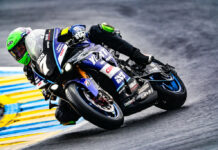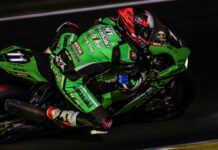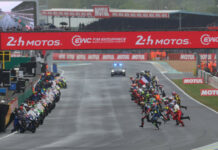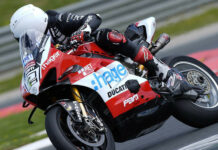FIM Road Racing World Championship Grand Prix – Changes to the 2009 Regulations – The Grand Prix Commission, composed of Messrs. Carmelo Ezpeleta (Dorna, Chairman), Claude Danis (FIM), Hervé Poncharal (IRTA) and Takanao Tsubouchi (MSMA), in the presence of Messrs Vito Ippolito (FIM President), Ignacio Verneda (FIM Sport Director), Javier Alonso (Dorna) and M. Paul Butler (Secretary of the meeting), in meetings held on March 18 in FIM Headquaters in Mies & on March 28 in Jerez de la Frontera (Spain) decided to introduce the following amendments to the Road Racing World Championship Grand Prix Regulations. For immediate application Sporting Regulations 1.11.3 ii) b) Entries (…) Teams must make every reasonable effort to provide a qualified substitute rider to fulfil their entry obligations. However no substitution or replacement of the entered rider may be made after 17h00 on the first day of the event except in the MotoGP class when the limit is 2 hours before the qualifying practice. (…) 1.11.8 A compulsory briefing will be held for all the riders who will be participating for the first time in the current Championship, at 10h30 on the day scheduled for the first practice session. Failure to attend the briefing in full will result in disqualification from the event. A waiver can be granted to a rider by the Race Direction. 1.13 Schedule 1.13.1 The Event schedule will be as follows: Wednesday : Arrival and setting up of Teams Thursday : Arrival and setting up of Teams 10:00 – 17:00 Technical and Sporting Checks and other formalities Friday Free Practices 125cc 13h05 – 13h45 MotoGP 14h05 – 14h50 250cc 15h05 – 15h50 Saturday Free Practices Qualifying Practice 125cc 09h05 – 09h45 13h05 – 13h45 MotoGP 10h05 – 10h50 14h05 – 14h50 250cc 11h05 – 11h50 15h05 – 15h50 Sunday Warm up Races 125cc 08h40 – 09h00 11h00 250cc 09h10 – 09h30 12h15 MotoGP 09h40 – 10h00 14h00 1.15.1 Practice Restrictions (“¦) The “Winter” is defined as the rest of the year, i.e. starting 5 days after the last race of the season and ending 14 days before the first race of the subsequent season, both dates being inclusive. The Winter does not include the “Pause”. The Pause is a period starting on the day after the last race of one year and finishing on the 31st January of the following year, both dates being inclusive. 1.15.1.1 MotoGP Class (practice restrictions) (“¦) b) Practice during the day immediately following an event at 2 circuits at which the event has taken place. The tyres used will not be counted. (“¦) 1.15.2 Practice Sessions (warm-up inclusive) (“¦) vi) For MotoGP only: At the start of the warm-up, the following procedure will apply: Pit-lane exit opens for 2 minutes. Count-down boards of 2, 1 minute and 30 seconds shown at the pit-lane exit. Pit-lane exit closes. Riders who are still in the pit-lane will not be allowed to practice start on the starting grid. Riders on the track complete one lap without stopping and go onto the starting grid. They stop on the starting grid, practice start and complete one lap without stopping and enter the pit-lane. As soon as the last rider has completed his lap, pit-lane exit opens to continue the warm-up. Technical Regulations 2.3.6 Engine Durability. 1.) In the MotoGP class the number of engines available for use by each rider is limited. For the 2009 season a maximum of 5 engines may be used by each rider for the 7 scheduled races from August 14 to November 8 inclusive. Should a rider be replaced for any reason, the replacement rider will be deemed to be the original rider for purposes of engine allocation. 2.) The engines available for the exclusive use of each rider must be marked and sealed by the Technical Director prior to first use. It is the Team’s obligation to register any new engine with the Technical Director prior to use. Once registered and used for the first time, engines may not be swapped between riders, even within the same team. A new engine is deemed to be used when the motorcycle with that engine crosses the transponder timing point at the pitlane exit. 3.) The engines will be sealed by means of wiring and identification tabs, so that: a. the timing system is not accessible (e.g. the head cover must be wired to the cylinder head), b. the timing driving system is not accessible (e.g. the geartrain/chain cover is wired so that it cannot be removed), c. the cylinder head and the cylinders block (if any) cannot be removed from the engine (e.g. the cylinder head is wired to the cylinders block and the cylinders block is wired to the engine crankcase), d. the crankcase cannot be opened (e.g. the crankcase halves are wired together). All the parts that are accessible without removing the sealing wiring can be replaced. Breaking or removing the sealing wiring without supervision by the Technical Director will be deemed to be “engine rebuilding” and engines with broken or missing security seals will be treated as a new engine in the allocation. 4.) Should a competitor, for any reason (e.g. mechanical failure, crash major damage, etc.) require the use of another engine above their allocation, the Technical Director must be informed before the new engine is used, and Race Direction will apply the following penalty: The rider will have 10 points deducted from his championship total when the new engine is first added to the allocation, whether or not the new engine is used in the race. 5.) There is no limit to the number of times a sealed, allocated engine can be fitted to and used in a motorcycle, provided the security seal is not broken or removed. Replacing an engine with another sealed engine (new or used) from the rider’s allocation is allowed with no penalty. To prevent the running of a used, allocated engine outside of MotoGP events, used engines will have security seals wired over the exhaust ports immediately after they are removed from the motorcycle. Teams wishing to re-use such a used, allocated and sealed engine must request the Technical Director to remove the exhaust port seals. If the Technical Director (or his staff) finds that such a used engine does not have the exhaust port seals in place, it will be deemed to be a new engine in the allocation, with the appropriate penalty. 2.3.7 Exhaust Gas Recirculation (EGR) systems are not permitted. 2.3.8 Control Systems 2.3.8.1 The use of hydraulic and/or pneumatic pressurized powered systems is not allowed, with the exception of cylinder inlet/exhaust valve springs. All hydraulic systems on the motorcycle must be powered only by the rider’s manual inputs. Normal hydraulic hand/foot controls such as master/slave cylinders for brakes/clutch are allowed. Pneumatic engine valve actuating systems are allowed. Oil/water pumps for engine lubricating/cooling are allowed. The use of engine lubricating oil for any purpose other than lubrication and cooling (such as powered hydraulic systems) is not allowed. 2.7.3 Brakes 2.7.3.1 Motorcycles must have a minimum of one brake on each wheel that is independently operated. 2.7.3.2 In the 125cc and 250cc classes, only brake discs of ferrous materials are allowed. 2.7.3.3 In all classes, ceramic composite materials are not permitted for brake discs or brake pads. Ceramic materials are defined as inorganic, non metallic solids (e.g. Al2O3, SiC, B4C, Ti5Si3, SiO2, Si3N4). 2.7.12 Suspension and Dampers 2.7.12.1 Electric/electronic controlled suspension and steering damper systems are not allowed. 2.10 Numbers and Backgrounds 2.10.1 Racing numbers must be affixed to the front and the two sides of the motorcycle. For the MotoGP class, only the front number is compulsory. 2.10.2 Numbers should be a minimum height of 140 mm. 2.10.3 Numbers must be easily legible and contrast strongly with the background colour. 2.10.4 Backgrounds must be of one single colour over an area large enough to provide a minimum clear area of 25mm around the numbers. 2.10.5 In case of a dispute concerning the legibility of numbers, the decision of the Technical Director will be final.
FIM Issues More Revisions To 2009 Grand Prix Regulations
FIM Issues More Revisions To 2009 Grand Prix Regulations
© 2009, Roadracing World Publishing, Inc.






